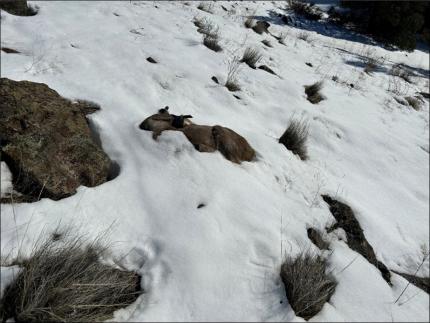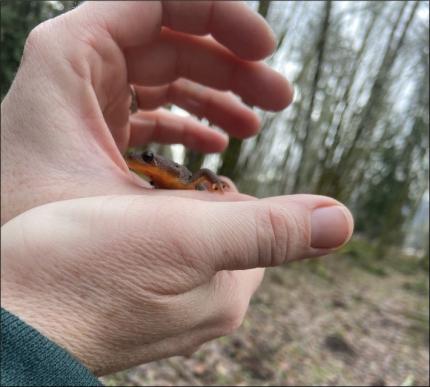Managing Wildlife Populations
Klickitat Mule Deer Aerial Survey Results: During the week of Dec. 11, Biologists Wickhem, Bergh, Holman, Jacobsen and Bundick conducted annual helicopter surveys for mule deer in GMUs 388 and 382. The survey consists of flying transects over 15 randomly selected survey units in Klickitat County between the Klickitat River and the eastern boundary of the county.
When a group of deer is located, they are counted and classified (age, sex, and number of antler points, if present). Several other covariates are also collected including vegetation type, amount of cover, amount of snow, etc.
Since the surveys were completed, Biologist Wickhem has been entering and analyzing data using the Idaho Sightability Model, a statistical model that uses the counts and covariates to estimate a population for the survey area. The model estimated that GMUs 382 and 388 have approximately 7,978 deer. There is considerable error in this estimate since the vegetation types used in the Idaho Sightability Model do not directly translate to the Washington landscape, however it is the closest model that currently exists.
We can still use these estimates along with harvest to monitor trends in the population. After dropping significantly from 2016 to 2017 following an extremely harsh winter, the population estimates have remained relatively stable. Since 2017, managers have removed nearly all anterless hunting opportunities in an attempt to rebound the population. On the upside, the estimated ratios of fawns and bucks for every 100 does were 56 and 23, respectively. Fifty-six fawns for every 100 does is on par with previous surveys and 23 bucks is the highest recorded buck to doe ratio since surveys began in 2016.

GPS-collared Mule Deer Mortalities: Biologist Bergh and Wildlife Conflict Specialist Jacobsen had a snowy adventure to GMU 382 to retrieve the GPS collars from two study deer that had died the previous week during the snow and ice storms. One of the deer was still completely intact and had been covered in snow until recently and the only parts left to the other deer were the spine, some ribs, and two legs. That deer had been scavenged by a coyote and several birds, so a cause of death was unable to be determined. The intact deer had diarrhea on her tail and there was bloody diarrhea nearby. Samples of the organ tissues were sent to the Washington Animal Disease Diagnostic Lab at WSU to test for evidence of disease.


Biologist Wickhem, Wildlife Conflict Specialist Jacobsen, and Volunteer Zoller responded to another “mortality signal” from a GPS collared deer later in the same week, this one in GMU 388. This retrieval required an approximately four-mile round trip excursion on snow-covered roads, that Wickhem thoroughly enjoyed on her skis, while Jacobsen and Zoller post-holed. Despite responding to the location as soon as possible, only one small piece of ribcage was found at the mortality location, making it impossible to determine the cause of death. The crew was able to locate the collar using radio telemetry, after a coyote carried it 400 yards from the carcass remains and buried it in the duff under a tree.


Injured Owl: Wildlife Conflict Specialist Jacobsen received a report regarding an injured great horned owl in the Goldendale area that needed transport to a rehabilitation center. Jacobsen responded to the residence and determined the owl was actually a western screech owl, which is substantially smaller than a great horned owl. The owl was in poor condition due to its wing having been wedged between two buildings – the owl dangled there for several days until the homeowner noticed it and freed it. Jacobsen transported the owl to Rowena Wildlife Clinic in Oregon, where it received treatment for its injuries.

Cascade Red Fox Report: Wildlife Conflict Specialist Jacobsen was contacted by a member of the public regarding a possible sighting of a Cascade red fox along the Idaho border. Jacobsen confirmed that the fox was a lowlands red fox, not a Cascade red fox. The Cascade red fox only inhabits alpine and subalpine habitat in the south Cascades and has a population size that is estimated to be around 50 individuals.

Track Survey: Wildlife Conflict Specialist Jacobsen accompanied Biologist Spence on a wolf track survey in the Gifford Pinchot Forest via snowmobile. Tracks of snowshoe hare, coyote, and cougar were observed, but no wolf tracks were detected.

Hunter Harvest Checks: Hunting seasons for some species continue. Regional wildlife biologists, wildlife conflict specialists, and customer service specialists continue to make checks of hunter harvested wildlife that have seasons continuing into the winter months. Many species of wildlife, including cougars and bobcats, have various checking requirements to facilitate biological sample collection and assure the legality of harvests. Hunters are reminded to check the Big Game Seasons Pamphlet in order to be clear on checking requirements for various species as well as season dates.
During this reporting period, Biologist Holman and Biologist Wickhem checked two cougars each. Wildlife Conflict Specialist Jacobsen checked a sub-adult male cougar from GMU 382 and a male bobcat from GMU 388.
Providing Conflict Prevention and Education
District 9 Cougar Sighting Report: Wildlife Conflict Specialist Jacobsen fielded a report of a cougar sighting in a residential area of Klickitat County. Jacobsen confirmed the sighting after viewing a video of the cougar.

District 9 Habituated Bear: Over the past two months, Wildlife Conflict Specialist Jacobsen responded to multiple complaints in eastern Clark County regarding a large black bear that had been accessing human food sources. Jacobsen worked with multiple landowners to correct improperly secured attractants, but the bear continued to seek out potential sources of food and eventually began ripping apart structures in search of food.
Normally, bears should be hibernating at this point in the season due to the widespread lack of available forage during the winter. Jacobsen determined that this bear had been habituated to accessing human food and attractants such as bird seed, likely over multiple years, based on landowner reports. Given that the bear had decided to “skip” hibernation this year, the lack of available natural forage in the area, the lack of suitable relocation sites in winter, and the level of damage the bear had been causing and degree of habituation he was exhibiting.
Jacobsen eventually trapped and lethally removed the 260 lb. male bear. This was an extremely unfortunate incident that likely could have been prevented if the landowners in the area had responsibly secured their attractants to prevent the bear from accessing them.


District 9 Cougar Encounter: Wildlife Conflict Specialist Jacobsen and Officer Bolton responded to an incident where an antler shed hunter had a close encounter with a cougar and ended up killing the cougar with his sidearm.
The shed hunter inadvertently came across the cougar while hiking through the woods. Unbeknownst to the shed hunter, the adult female cougar was feeding on a deer kill when the shed hunter passed by. The shed hunter looked up and saw the cougar roughly 30 yards away. At that point, the shed hunter stopped walking forward and began to back up, while chambering a round in his sidearm. The cougar, likely trying to scare the shed hunter away from her kill, turned towards the shed hunter and flattened her ears back in a defensive posture. Fearing for his safety, the shed hunter fired a shot at the cougar. The cougar began running towards him while the shed hunter continued firing his sidearm. The cougar eventually ran past the shed hunter and died from multiple gunshot wounds a short distance past the hunter.
This chain of events is extremely uncommon and was likely due to the cougar trying to scare the shed hunter away from her kill. Washington Department of Fish and Wildlife encourages outdoor recreationists to be prepared to encounter wildlife such as cougars by carrying bear spray as well as by being familiar with cougar habits and behavior. If a cougar is encountered in the wild, recreationists are encouraged to make loud noises, appear as big as possible, and give the animal its space. More information on encountering cougars in the wild can on the WDFW website.

District 9 Elk Damage to Hay Field: A landowner contacted Wildlife Conflict Specialist Jacobsen regarding elk damage to a hay field. The landowner has had a poor hay crop on the field for the past few years due to persistent elk damage and requested a Master Hunter from the Region 5 elk damage pool to assist in lethally removing the elk from the property. Jacobsen deployed an elk hunter to the property, who harvested a hoof-diseased elk within a short time of his arrival at the field. This particular elk group has had a high prevalence of Treponeme-associated hoof disease (TAHD) among individuals there for several years.

Conserving Natural Landscapes
Charismatic Mini-fauna on Mount Saint Helen’s Wildlife Area: When we first think of managing wildlife areas, we typically think of managing habitat for large and/or well-known species like elk and waterfowl. However, Wildlife Areas provide important habitat for a variety of species. While working on the Mount Saint Helen’s Wildlife Area, Assistant Manager Risley and Technician Crane observed some of the charismatic mini-fauna that call the wildlife area home.


